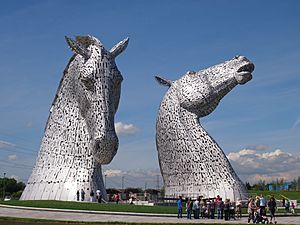The Helix (Falkirk) facts for kids
Quick facts for kids
The Helix, Home of the Kelpies
|
|
|---|---|

The Kelpies, which tower over the new canal at The Helix
|
|
| Official name | The Helix, Home of the Kelpies |
| Maintained by | Scottish Canals and Falkirk Council |
| History | |
| Construction start | April 2006 (official planning) |
The Helix is a huge park and outdoor space in Falkirk, Scotland. It was created to connect 16 different communities. The project also aimed to improve the eastern end of the Forth and Clyde Canal. This area is near where the canal meets the River Carron. The most famous part of The Helix is two giant horse sculptures called The Kelpies.
Contents
What is The Helix?
The Forth and Clyde Canal was reopened in 2001. This was part of a big project called the Millennium Link. It included the Falkirk Wheel, a 100-foot (30-metre) tall boat lift. This lift connects the Forth and Clyde Canal to the Union Canal. By 2014, the Falkirk Wheel was one of Scotland's most popular places to visit.
The canals leading to Glasgow and Edinburgh also became very popular. However, the last 4 miles (6 kilometres) of the Forth and Clyde Canal was not used much. This part of the canal had 14 locks and led to Grangemouth. The original path to Grangemouth Docks was blocked by roads, houses, and factories. A new route was made to the River Carron. But this route had problems too. Bridges over the river made it hard for boats to pass. Sometimes the water was too high, and sometimes too low. So, a better way was needed.
How The Helix Project Started
The chance to fix these problems came from the Big Lottery Fund. They had a program called Living Landmarks. This program offered a lot of money for big projects. In 2005, The Helix project won one of the top awards. This helped start the £43 million project.
The plans for The Helix included a new 950-yard (870-metre) section of canal. This new part would join the river below the bridges. A new sea lock would also be built. Workers also built a new tunnel under the M9 motorway. They used a method called "cut and cover" for this. A lift bridge was also added to the A905 road. Two important oil pipelines that crossed the area also had to be moved.
What You Can Find at The Helix
The project changed unused land between Falkirk and Grangemouth. It became a lively green space called "The Helix." This area now has a special stage for events. There's also a large lagoon for water sports. Play areas and nice paths surround everything. The main part is called Helix Park. The whole area covers about 350 hectares (860 acres). You can explore The Helix on 27 kilometres (17 miles) of paths for bikes and walking.
The name 'Helix' comes from the way the project spirals. It goes from Langlees down to Laurieston and Polmont.
Funding The Helix
Falkirk Council led the effort to get money from the Big Lottery Living Landmarks program. They worked with British Waterways (Scotland) and Central Scotland Forest Trust. In 2007, their plan was chosen. Out of 316 entries, only 3 won. The Helix received £25 million. This was the first time a project in Scotland got so much money from this program. It was also the largest amount BIG had ever given to a single project at that time. In 2009, Falkirk Council created the Helix Trust. This group would help manage the first part of the project.
Other groups also gave money. These included the Scottish Government, Sustrans, Score Environmental, and Forth Environmental Trust.
In 2012, a company called Balfour Beatty won a £13.5 million contract. They built the new canal. Another company, Nicholl Russell Studios, designed the visitor centre. They won a £1 million contract for that.
The Kelpies
The most famous part of The Helix is the two amazing horse sculptures called The Kelpies. Each sculpture is about 100 feet (30 metres) tall. The idea for The Kelpies came from an artist named Andy Scott. He also made the "Heavy Horse" sculpture near the M8 motorway. Another idea for The Kelpies came from a real horse named Carnera. He was the biggest Clydesdale horse in the UK. Carnera used to live in Falkirk and pulled wagons of Irn-Bru for Robert Barr.
Building the foundations for The Kelpies started in early 2013. These foundations weighed 1,600 tonnes! The steel parts for The Kelpies were made in North Yorkshire. Delivery of the main steel began in March 2013. Each Kelpie weighs 300 tonnes. After the steel frames were put up, workers covered them with 990 uniquely shaped stainless steel plates. The sculptures were finished in October 2013.
You can visit The Kelpies and even go inside them. This lets you see how complex and impressive their inner structure is. By December 2012, the canal channel was dug out. The first big artwork was put up in the Abbotshaugh Community Woodland in early 2013. The whole project was planned to be finished by the summer of 2014.
See also

